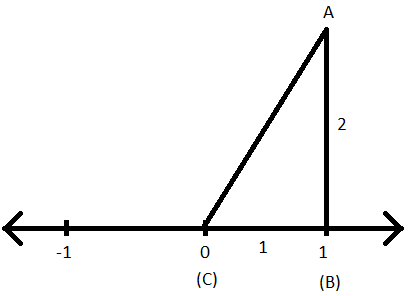Steps involved are as follows:
Step I: Draw a number line and mark the center point as zero.
Step II: Mark right side of the zero as (1) and the left side as (-1).
<a href="http://www.math-only-math.com/images/irrational-numbers-number-line.png" rel="gallery[pageGallery]" title="Irrational Numbers Number Line"> </a>
</a>
Step III: We won’t be considering (-1) for our purpose.
Step IV: With 2 units as length draw a line from (1) such that it is perpendicular to the line.
Step V: Now join the point (0) and the end of new line of 2 units length.
Step VI: A right angled triangle is constructed.
Step VII: Now let us name the triangle as ABC such that AB is the height (perpendicular), BC is the base of triangle and AC is the hypotenuse of the right angled triangle ABC.
<a href="http://www.math-only-math.com/images/square-root-of-5.png" rel="gallery[pageGallery]" title="Square Root of 5"> </a>
</a>
Step VIII: Now length of hypotenuse, i.e., AC can be found by applying Pythagoras theorem to the triangle ABC.
AC2 = AB2+ BC2
⟹ AC2 = 22+ 12
⟹ AC2 = 4 + 1
⟹ AC2 = 5
⟹ AC = √5
<a href="http://www.math-only-math.com/images/square-root-of-5-on-number-line.png" rel="gallery[pageGallery]" title="Square Root of 5 on Number Line"> </a>
</a>
Step IX: Now with AC as radius and C as the centre cut an arc on the same number line and name the point as D.
Step X: Since AC is the radius of the arc and hence, CD will also be the radius of the arc whose length is √5.
Step XI: Hence, D is the representation of √5 on the number line.
<a href="http://www.math-only-math.com/images/represent-square-root-of-5-on-number-line.png" rel="gallery[pageGallery]" title="Represent Square Root of 5 on Number Line"> </a>
</a>




 myCBSEguide
myCBSEguide

Arpita Banerjee 8 years, 4 months ago
Steps involved are as follows:
Step I: Draw a number line and mark the center point as zero.
Step II: Mark right side of the zero as (1) and the left side as (-1).
<a href="http://www.math-only-math.com/images/irrational-numbers-number-line.png" rel="gallery[pageGallery]" title="Irrational Numbers Number Line"> </a>
</a>
Step III: We won’t be considering (-1) for our purpose.
Step IV: With 2 units as length draw a line from (1) such that it is perpendicular to the line.
Step V: Now join the point (0) and the end of new line of 2 units length.
Step VI: A right angled triangle is constructed.
Step VII: Now let us name the triangle as ABC such that AB is the height (perpendicular), BC is the base of triangle and AC is the hypotenuse of the right angled triangle ABC.
<a href="http://www.math-only-math.com/images/square-root-of-5.png" rel="gallery[pageGallery]" title="Square Root of 5"> </a>
</a>
Step VIII: Now length of hypotenuse, i.e., AC can be found by applying Pythagoras theorem to the triangle ABC.
AC2 = AB2+ BC2
⟹ AC2 = 22+ 12
⟹ AC2 = 4 + 1
⟹ AC2 = 5
⟹ AC = √5
<a href="http://www.math-only-math.com/images/square-root-of-5-on-number-line.png" rel="gallery[pageGallery]" title="Square Root of 5 on Number Line"> </a>
</a>
Step IX: Now with AC as radius and C as the centre cut an arc on the same number line and name the point as D.
Step X: Since AC is the radius of the arc and hence, CD will also be the radius of the arc whose length is √5.
Step XI: Hence, D is the representation of √5 on the number line.
<a href="http://www.math-only-math.com/images/represent-square-root-of-5-on-number-line.png" rel="gallery[pageGallery]" title="Represent Square Root of 5 on Number Line"> </a>
</a>
1Thank You